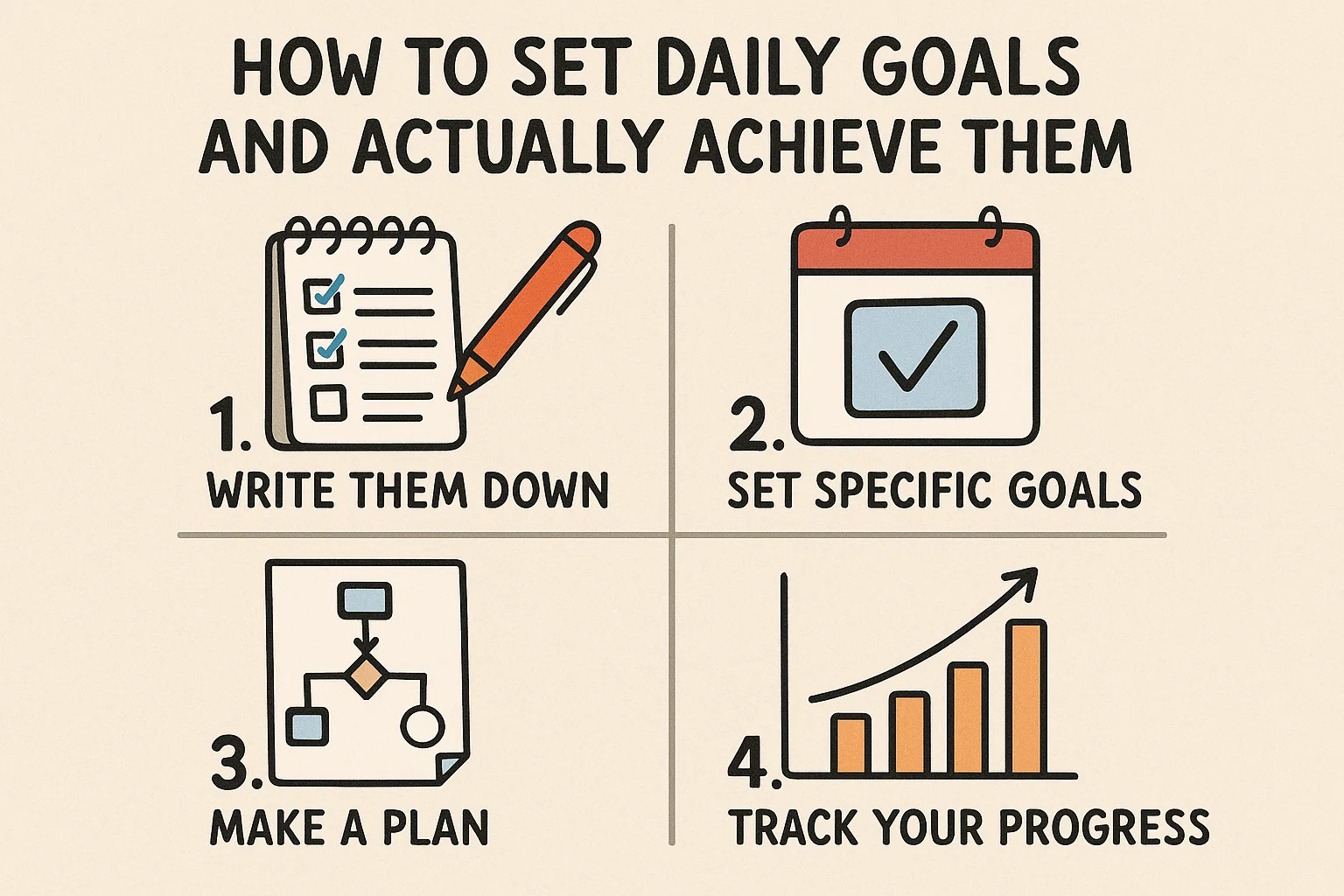A Simple Strategy to Win Every Day
Success is not built overnight—it’s built daily. One powerful way to make progress every single day is by learning how to set daily goals and stick to them. Daily goals give you clarity, boost your productivity, and create a strong sense of purpose. When done right, goal-setting becomes a habit that fuels long-term success.
In this guide, you’ll discover practical techniques backed by psychology, planning strategies like SMART goals, and modern tools to help you stay focused and achieve what matters most.
1. Why Setting Daily Goals Matters
Setting daily goals gives your day a clear direction. Instead of reacting to whatever comes your way, you’re driven by purpose and intention. This mental clarity helps you become more productive and feel accomplished at the end of the day.
When you define what you want to achieve each day, you create a clarity loop in your mind. This loop helps your brain filter distractions and focus on what really matters.
By planning your day with intention, you can boost your focus, energy, and results. That’s why the importance of daily goals can’t be overstated—they are the foundation of a purpose-driven day.
2. The Psychology Behind Goal Achievement
Our brains love progress. When we accomplish a task, even a small one, the brain releases dopamine, creating a sense of reward and motivating us to continue.
Understanding the mental strategy for goals helps you use this biological response to your advantage. Setting achievable goals creates mini wins that keep you engaged and focused throughout the day.
The key is to design goals that activate your brain’s achievement circuit. These are clear, manageable tasks that lead to a sense of momentum. This kind of internal motivation is more powerful and lasting than external rewards.
3. How to Structure SMART Daily Goals
To make daily goals truly effective, use the SMART goal formula: Specific, Measurable, Achievable, Relevant, and Time-bound.
Here’s how it works:
- Specific: Be clear. Instead of “work on my project,” say “write the introduction to the project report.”
- Measurable: Track progress. Can you check it off?
- Achievable: Make sure it fits within your time and energy for the day.
- Relevant: Align it with your bigger goals.
- Time-bound: Assign a deadline—today.
Breaking goals into realistic daily tasks makes them less overwhelming. With this goal-setting formula, you turn your to-do list into a system that drives results.
4. Time-Blocking Your Daily Goals
Once you have your daily goals, the next step is to block time in your schedule to complete them.
Time-based goals become real when you assign them to specific time slots. Use your calendar or planner to block 30- to 90-minute sessions for focused work. This prevents multitasking and builds strong focus habits.
If you’re new to this, try the Pomodoro technique—25 minutes of focused work followed by a 5-minute break. Over time, these routine blocks help you control your time better and match your energy to the most important tasks.
By aligning your energy and effort with clear time blocks, you build consistency and momentum.
5. Prioritizing What Matters Most
Not all goals are equal. Some tasks move you forward more than others. That’s why you need to prioritize your daily goals using simple frameworks.
Start with identifying your MITs (Most Important Tasks). These are the top 2–3 goals that must get done today, no matter what.
Use tools like the Eisenhower Matrix to sort your tasks by urgency and importance. This way, you focus on high-impact goals instead of wasting energy on less valuable ones.
By creating a goal triage system, you ensure your most meaningful work always comes first. This boosts both your efficiency and your results.
6. Tracking and Reviewing Progress
One of the most powerful productivity habits is reviewing your goals daily. This simple step creates a feedback loop that keeps you focused and helps you learn from your wins and challenges.
Use a goal journal or habit tracker to log your progress. At the end of the day, ask:
- What did I complete?
- What needs improvement?
- What should I do differently tomorrow?
This kind of self-assessment turns goal-setting into a learning process. With a consistent progress review, you become more intentional, accountable, and successful over time.
7. Tools and Apps to Help Set Daily Goals
Technology makes daily goal planning easier than ever. There are many digital tools and templates that can support your routine.
Here are some of the best tools:
- Todoist – Great for daily task lists and goal categories.
- Google Calendar – Excellent for blocking time and setting reminders.
- Notion – A flexible system to combine notes, goals, and planning dashboards.
- Habitica – Turn your goal tracking into a fun game-like experience.
These daily planner tools help you create a goal dashboard that’s visible and motivating. Whether you prefer digital planners or printable templates, having a system keeps your goals top of mind.
Final Thoughts
Learning how to set daily goals is a life-changing habit. It improves your focus, boosts your productivity, and brings you closer to your long-term dreams—one day at a time.
Start today:
- Write down 3 SMART goals for tomorrow.
- Block 1 hour to focus on your MIT.
- Track your progress for one week.
With these simple steps, you’ll transform your daily routine into a results-driven success system.
